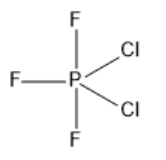
What are the bond angles of
Answer
418.5k+ views
Hint :The bond angle generally depends on the number of lone electron pairs, size and electronegativity of the central atom and also the size of atoms surrounding it. Note that the molecule
Complete Step By Step Answer:
Phosphorus atoms have fifteen electrons with a total of five valence electrons. Three of these electrons are involved in bond formation with fluorine atoms and two electrons are involved in the bond formation with chlorine atoms. So, the hybridization of

Note :
Remember that the bond angle of a molecule depends mainly on the number of lone pairs and the electronegativity of the central atom. Note that more electronegative atoms occupy the axial position in a molecule which has trigonal bipyramidal geometry.
Complete Step By Step Answer:
Phosphorus atoms have fifteen electrons with a total of five valence electrons. Three of these electrons are involved in bond formation with fluorine atoms and two electrons are involved in the bond formation with chlorine atoms. So, the hybridization of

Note :
Remember that the bond angle of a molecule depends mainly on the number of lone pairs and the electronegativity of the central atom. Note that more electronegative atoms occupy the axial position in a molecule which has trigonal bipyramidal geometry.
Recently Updated Pages
Express the following as a fraction and simplify a class 7 maths CBSE

The length and width of a rectangle are in ratio of class 7 maths CBSE

The ratio of the income to the expenditure of a family class 7 maths CBSE

How do you write 025 million in scientific notatio class 7 maths CBSE

How do you convert 295 meters per second to kilometers class 7 maths CBSE

Write the following in Roman numerals 25819 class 7 maths CBSE

Trending doubts
State and prove Bernoullis theorem class 11 physics CBSE

What are Quantum numbers Explain the quantum number class 11 chemistry CBSE

Write the differences between monocot plants and dicot class 11 biology CBSE

Who built the Grand Trunk Road AChandragupta Maurya class 11 social science CBSE

1 ton equals to A 100 kg B 1000 kg C 10 kg D 10000 class 11 physics CBSE

State the laws of reflection of light




